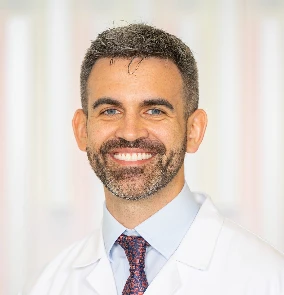2731 - Incidence and Clinical Outcomes of Radiation-Induced Second Malignancies Among Patients Treated for HPV-Associated Oropharyngeal Cancers at a Single Institution
Presenter(s)

E. M. Davies1, C. A. Reddy2, K. Dennert3, R. W. Davis4, S. A. Koyfman4, J. A. Miller5, J. L. Geiger6, T. A. Sussman7, K. Burkitt5, B. Prendes8, N. Silver8, and N. M. Woody4; 1Department of Radiation Oncology, Taussig Cancer Center, Cleveland Clinic, Cleveland, OH, 2Department of Radiation Oncology, Cleveland Clinic Foundation, Cleveland, OH, 3Cleveland Clinic Foundation, Cleveland, OH, 4Department of Radiation Oncology, Taussig Cancer Institute, Cleveland Clinic, Cleveland, OH, 5Cleveland Clinic, Cleveland, OH, 6Department of Hematology and Medical Oncology, Taussig Cancer Center, Cleveland Clinic, Cleveland, OH, 7Department of Hematology/Oncology, Taussig Cancer Institute, Cleveland Clinic, Cleveland, OH, 8Department of Otolaryngology, Head and Neck Institute, Cleveland Clinic, Cleveland, OH
Purpose/Objective(s): HPV-associated malignancies of the oropharynx are commonly treated with either definitive radiotherapy (RT) or, in the case of early-stage tumors, transoral robotic surgery (TORS). A concern with use of RT is the incidence of radiation-induced second malignancies (RISM) and a careful understanding of the rate may influence choice of therapy. We report incidence of RISM and clinical outcomes from a large cohort of patients from our institution with extended longitudinal follow-up.
Materials/Methods: We abstracted from our IRB-approved institutional database for cancers of the head and neck, patient data, tumor characteristics and clinical outcomes of all HPV-positive cancers of the oropharynx treated with definitive intensity-modulated RT from 1/2009 to 12/2020 at our center. RISM were defined as tumors occurring within the 50% isodose line of the index tumor (IT) with at least one of the following features: tumor occurring >5 years from treatment; occurrence at a geographically distinct site or subsite; or a histopathologically distinct primary tumor (including HPV-negative status). Cumulative incidence analysis was performed using tumor recurrence as a competing risk to calculate the rates of RISM over time. Each RISM was managed with surgery and pathologic data was compiled.
Results: The median follow up for the entire cohort of n=662 patients was 58.4 months (range: 0.0 to 159.9 m), and the median age was 60 years (range: 35-96 years). A total of 8 patients (1.2%) developed RISM ranging 19.4-140.0 months after RT. The cumulative incidence of RISM was 0.37% (95% CI: 0.08%-1.28%) at 5 years and 1.74% (95% CI: 0.70%-3.65%) at 10 years. The locations of IT receiving definitive RT were tonsil (5), base of tongue (2), and soft palate (1). The median RT prescription dose in the dataset was 70 Gy. In the 8 patients developing RISM, RT prescriptions ranged from 70-74 Gy, and 6 received concurrent chemotherapy. 7 of 8 patients received RT to the bilateral necks, and the remaining patient received RT to the ipsilateral neck. RISM occurred at subsites distinct from the IT in 7 of the 8 patients. Surgery including neck dissection was a component in the treatment of all 8 RISM. The most common AJCC risk group RISM was IVA, based on size. All 8 RISM were pN0. Patients developing RISM had more extensive smoking history compared to patients with no second primary (median 5 vs 14 pack-years). The actuarial overall survival rates for the entire HPV-positive patient cohort receiving IMRT was 83% (95% CI: 80-86%) at 5 years and 69% (95% CI: 64-75%) at 10 years. Disease recurrence occurred in 109 patients (16.6%).
Conclusion: The cumulative incidence of RISM among patients receiving definitive RT to index HPV-positive oropharynx tumors is not trivial in this large cohort. RISM in this database present with pathologically large tumors and pathologic node negativity. Future investigations require a larger collaborative dataset to refine estimates of patients at risk of RISM in whom TORS may be preferred.
